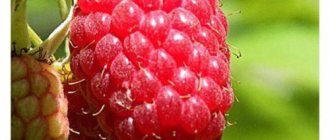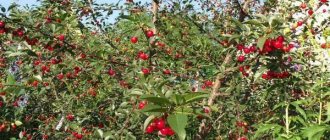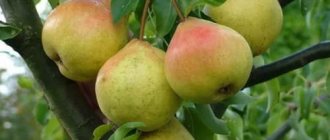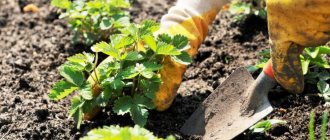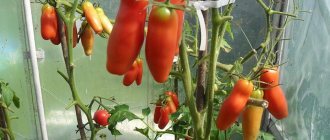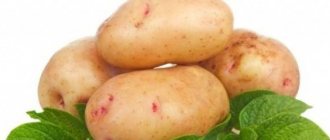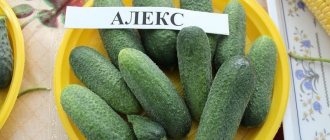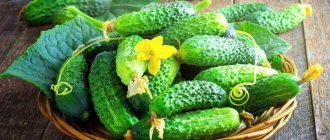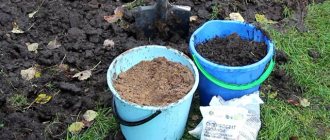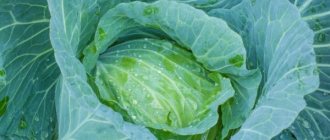Photo and description of raspberry Phenomenon
This raspberry differs from other varieties in the following characteristics:
- long branches can reach three meters. They have sharp thorns. The bushes themselves are spreading;
- young shoots are light brown at the beginning of the season, but then turn yellow;
- new shoots appear very quickly, so the raspberry tree needs to be periodically thinned out during the season;
- classic leaves are green, the lower part is lighter. There are veins;
- excellent frost resistance;
- the plant tolerates short-term drought well;
- the root system grows quickly, so gardeners periodically have to dig up young shoots that are located outside the raspberry patch;
- The high immunity of the plant allows it to bear fruit regardless of disease damage.
Reference! Raspberries of the Phenomenon variety quickly became popular throughout Russia. Today it is also grown on the territory of the former Soviet republics. There is more sun, so the yield is slightly higher.
Raspberry variety Phenomenon
Almost every garden plot will definitely have several raspberry bushes. To enjoy delicious and aromatic berries in the summer, you need to choose the best one from the variety of varieties.
It is important that the variety is high-yielding, unpretentious in care, and the fruits have excellent taste
In all respects, the raspberry Phenomenon deserves attention
Description of Raspberry Phenomenon
Brought out in 1991 in Ukraine thanks to the efforts of the scientist N.K. Gonchar. The phenomenon arose as a result of crossing Odarka and Stolichnaya and became widespread.
Distinctive features of the raspberry phenomenon:
- the plant is semi-spreading, up to 3 m high. It has thorns. During the fruiting period it is prone to lodging, so a garter is required. A characteristic feature is a change in the color of the branches. At the beginning of the year the stems are light beige, at the end they are yellow;
- The fruits are juicy, aromatic, and sour. The berries are bright red, large, the weight of individual specimens reaches 10 g. The shape is cone-shaped. The fruits are dense and tolerate transportation well;
- bush yield - up to 8 kg. Fruiting time – mid – end of July;
- When fresh, it retains its properties for 5 days. Storage conditions: up to 3°C;
- suitable for freezing, grinding with sugar and canning;
- resistant to pathogens;
- has high frost and drought resistance.
Thanks to these characteristics, the Phenomenon raspberry has won the love of many gardeners. And for many years since its creation, it has never ceased to delight with its excellent taste and ease of care.
Planting material
When choosing seedlings, carefully examine the roots and buds. There should be more than three buds at the base of a young plant. They are the ones who will produce fruit-bearing branches next year. Good root development and the presence of buds mean a healthy and strong bush in the future.
The length of the shoot, as well as the thickness of the trunk, is not important. However, you should refrain from purchasing planting material less than 1 cm thick.
During transportation, the roots are wrapped with a wet cloth. Storage in direct sunlight is prohibited. If it is not possible to plant immediately in a specific place, the shoot is temporarily buried.
Landing location
The optimal choice is fertile, moist soil and no groundwater nearby. The place chosen for planting should not be flooded, otherwise root rot is inevitable.
Loose, sandy-loamy soil that retains moisture and has drainage properties is ideal. It is better to place the bushes along the fence in a well-lit area, or to give a corner of the garden for planting.
Raspberries should be kept away from other plants, as they grow very large and dry out the soil.
Soil preparation and planting
Every 60 - 80 cm, dig holes measuring 30 x 30 cm. Before planting, add the following to the hole:
- 3 – 5 kg of manure or humus;
- 0.2 kg of superphosphate;
- 0.1 kg of wood ash or potassium salt.
Fertilizers are mixed with the soil. The need for their application is explained by the rapid establishment of seedlings and favorable wintering.
The seedlings are lowered into the hole, the roots are straightened, and sprinkled with earth.
The branches are cut to 30 cm, the leaves are removed.
Water at the rate of 1 bucket of water per 3–4 bushes. Mulch with peat, humus or manure.
Care
Productivity directly depends on the care the bushes received throughout the year.
In order to please the Phenomenon’s harvest, it is important to consider the following points:
Wintering
The variety does not require special wintering conditions. Sufficient natural snow cover. Before wintering, remove the remaining leaves. This prevents them from rotting and prevents rot from spreading to the buds in the spring.
The Phenomenon raspberry variety has become widespread due to its stable and high yield and resistance to adverse climatic factors. And the unique taste has made Phenomenon one of the most favorite delicacies of children and adults.
Productivity per bush
Gardeners love this raspberry for its high yield. You can get a considerable harvest even in not the best years for this variety:
- the minimum harvest from one bush is 6 kg;
- optimal harvest per bush – 8 kg;
- high yield - 12 kg.
Reference! The berries of this raspberry variety are quite large. They reach 4–5 grams. Some can weigh up to 8 grams. They contain 6.5% acid, so the taste is quite sweet, but there is a slight sourness that gives the berry a piquant flavor. The harvest is easily separated from the stalk.
Main characteristics of the variety
Many amateur gardeners consider this variety of raspberries to be a real breakthrough and the pride of breeders. The variety is distinguished by its rather large berry size and good growth and fruiting characteristics. It has an excellent presentation and can be safely recommended for growing in gardens with a temperate climate.
The variety was bred about 20 years ago by V.V. Kichina at the Moscow VSTiPS by crossing the raspberry variety “Stolichnaya” with the donor “Stambovy - 20”
At first the hybrid was considered experimental, but then, since 1998, it has been offered as an independent variety. It is distinguished not only by high yield, but also by excellent frost resistance, which is extremely important in the unpredictable and sometimes harsh climate of the central regions. Raspberries are mid-season varieties. The fruiting period begins in early July and lasts until the first ten days of August
During the season, it is quite possible to carry out 5 - 6 main harvests. The productivity of one bush is quite high - 4 - 5 kg with proper care. The bush is not very spreading, reaching a little more than 1.5 - 2 m in diameter. The stems are quite dense and strong, thick, their pubescence is weak, and there is no waxy coating. A big plus of the variety is the absence of thorns. Shoots grow quite quickly, up to 10 new ones appear per season. There are 7 - 12 replacement shoots, and 5 - 7 root shoots. The leaves have a juicy green tint, with a shiny, slightly wrinkled upper side. They have deep veins. The leaf plate has serrations along the edge. The fruits have a light red hue, the structure is velvety, with a slight bump. Weight 8 - 12 g, very large berry with a specific sweet and sour taste, aromatic. Some reach a mass of about 23 grams. You can grow from 20 to 30 berries on one stem. The shape resembles an elongated cone, but the top of the fruit is not sharp. The pulp of the berry has good taste: juicy, soft, with small seeds. Sometimes you can find double berries on the bush. The great advantage of the variety is that the ripe berries practically do not fall off and are easily torn from the stalk. The variety is not remontant, but the fruiting is stable. The shrub is self-fertile, but it is better to plant at least a few seedlings, then you can get a fairly large harvest. Among the advantages of this raspberry variety are, of course, good resistance to frost and harsh climates in the winter months, and Pride of Russia tolerates arid climates well. The temperature, which is easily tolerated by the plant, can reach up to – 30 degrees. Experienced gardeners still recommend covering the plant in the winter, since there are frequent cases of icing and freezing of the root system. The shrub has also been noted to have good resistance to various types of infections and diseases, such as root rot, chlorosis, mosaic, botrytis, anthracosis, and didimella. Since the berries are separated well, they are transported well too, they do not wrinkle or leak.
If you decide to plant seedlings on the shady side of the garden plot, then perhaps the taste will deteriorate a little: sourness may appear, which is one of the disadvantages of this variety.
Pros and cons of the variety
It is worth taking a closer look at the main advantages and disadvantages of the Phenomenon raspberry in order to understand what can be expected from it and what problems the gardener will have to face. The advantages include the following qualities of the variety:
- high productivity;
- tolerates drought well;
- good immunity to diseases and pest attacks;
- fruits can be easily transported;
- excellent taste characteristics;
- unpretentiousness.
However, each raspberry variety has its own disadvantages. In particular, the Phenomenon has the following:
- pests attack Phenomenon raspberries more often than other varieties;
- fear of soil waterlogging.
These are the main problems that gardeners will have to face. Having chosen the Phenomenon raspberry, you must be prepared to treat it with industrial poisons.
Brief characteristics of mid-season raspberries Phenomenon
Culture with its advantages and disadvantages.
Minuses:
- fruits with normal taste;
- The flavor of the berries depends on the soil, organic matter and salt content.
Pros:
- High yield crop. Each bush produces 6 to 8 kg of fruit.
- Phenomenon raspberries ripen at the same time and do not fall off.
- Shrub with high winter hardiness. They don't cover him.
- Raspberries are easy to care for and have high vitality.
- Plants are drought-resistant. If you water regularly, even in the heat, the berries will not bake.
- Immunity to viruses, fungal diseases and gall midges.
- The fruits are well transported.
Landing
Young shoots can be planted in spring or autumn. Regardless of when to do this, you must follow these steps:
- First, a hole or trench is dug, the depth of which is 60 cm. It is necessary to ensure that groundwater does not pass underground to a depth of one meter.
- Next comes soil fertilization. It is recommended to use humus, as manure can burn the young roots of the plant due to the release of ammonia.
- After this, you need to place the seedling in a hole or trench and cover it with soil. Lightly compact the soil.
- At the end, watering occurs.
Reference! Some gardeners first water the hole and then plant the plant. In this case, it is possible to achieve better adhesion of the roots to the soil. Both methods have the right to life.
When choosing when to plant Phenomenon raspberries, one must take into account that a developed root system will better survive harsh winters, and young roots will spend less nutrients during wintering.
Aftercare
The raspberry variety “Phenomenon” does not require special care; for normal growing season it is recommended:
- Fertilizing in the spring with phosphate and potassium fertilizers, in the fall with organic matter.
- Watering is moderate during flowering until the raspberries ripen, then it is stopped and resumed in the fall before frost.
- The bush is formed twice. In spring, frost-damaged stems are removed. The main pruning of Phenomenon raspberries is carried out in the fall; stems that are two years old are removed and young shoots are shortened.
- Supports are installed for fixation.
- For the winter, the “Phenomenon” raspberry bush is not covered; the root circle is mulched with sawdust, dry leaves or peat.
- To prevent rodents, a toxic agent is placed between the raspberry bushes.
Watering
It is necessary to water raspberries carefully, because they do not tolerate waterlogging. If the soil contains a large amount of moisture for a long time, the roots begin to rot.
It is worth considering the following:
- One bush requires no more than 15 liters of water. When planting occurs in a trench, 40–50 liters of water are needed per square meter.
- To prevent water from spilling outside the raspberry tree, it is worth making small furrows, the depth of which will be about 15 cm.
- Before watering, you need to make sure that the soil is dry to a depth of about 5 cm.
Reference! Raspberry Phenomenon grows better in a trench because the root system grows quickly and new shoots appear. If holes are used for planting, the distance between them should be at least 80 cm.
Rules for planting and care
The key to good harvests is proper planting
Where and how to plant raspberries
Raspberries grow and bear fruit best in sufficient sunlight, so they should be planted on the south or southeast side of the site. Groundwater should be located no closer than 1.5 m from the surface of the earth - for all its moisture-loving nature, raspberries do not tolerate stagnation of water.
Phenomenon raspberries are planted in both spring and autumn. Spring is considered a more favorable season for planting, as seedlings will have more time to take root and develop before the onset of winter.
The best type of soil for raspberries is loamy soil that has good air and water permeability. The soil reaction is preferably neutral or slightly acidic (pH 5.8–6.7). A large amount of nutrients is required.
Clay soil contains little oxygen and raspberry roots can rot. In this case, it is better to prepare high beds of bulk soil for plants. Raspberries should be planted on artificial mounds when groundwater is close and in areas with frequent and heavy rainfall. In contrast, in areas with very dry soil, planting should be done in furrows.
If the soil on the site is not fertile enough, it is necessary to properly prepare it. Pre-planting preparation can be carried out both in spring and autumn, and includes digging the soil, removing weeds, leveling the soil surface and adding nutrients. For each square meter of future raspberry garden, you need to add 7–8 kg of compost with the addition of 0.1 kg of superphosphate and 50 g of potassium salts. Fertilizers are embedded into the soil to the depth of a spade bayonet.
Raspberries can be kept in one place for 8–10 years. During this period, it takes a large amount of nutrients from the soil (5 times more than gooseberries). Therefore, without preliminary enrichment with fertilizers, the soil will quickly deplete even if fertilizing is applied.
Planting material can be purchased (pay attention to the development of the root system, the absence of signs of rot or diseases on the roots and trunk) or you can obtain it yourself. The phenomenon produces a fairly large amount of shoots, so harvesting seedlings is not difficult. You need to select the strongest offspring, carefully dig them up and separate them from the mother bush along with a bunch of roots and a lump of earth. After transplanting such a scion, you need to carefully care for it and water it regularly until rooting occurs.
You can use another method - propagation by layering. To do this, one of the raspberry stems is bent to the ground, several cuts are made on it, placed in a shallow (5-6 cm) groove and covered with earth. Provided the soil is well moistened, such digging will soon produce roots.
Raspberry propagation by layering - video
For planting raspberries, prepare holes 0.4 x 0.4 m or trenches of similar width and depth. They add a mixture of soil and fertilizer at the rate of 4–5 kg of humus, 150–200 g of superphosphate and 100 g of ash per plant. The nutrient layer is sprinkled with clean soil.
Before planting, the raspberry seedling is trimmed to a height of 30–35 cm; it is advisable to remove the leaves.
The distance between neighboring plants should be maintained within 60–80 cm, between rows - 1.5–2 m.
The seedlings are placed in the prepared recesses, having previously straightened the roots, and covered with soil. After compacting the soil around the stem, water each bush with 10 liters of water. The soil needs to be mulched with a layer of peat or humus.
Recent Entries
5 working ways to use tar in the garden 7 indoor plants that help you get married even in adulthood Indoor plants that can bloom in trouble
The author has repeatedly successfully planted raspberries in a small trench 1.5 shovels deep and 1 bayonet wide. A layer of heavily moistened sawdust 7–8 cm thick is laid at the bottom of the trench. The sides of the trench are laid with slate or sheet iron - this prevents the raspberries from spreading beyond the raspberry tree. You can pour half a bucket of compost under each bush and then water it properly. With this method of planting, raspberries are well accepted and grow actively.
Planting raspberries on video
How to care for raspberries
Raspberry Phenomenon is unpretentious and does not require special care. The bushes are capable of bearing a large fruit load, but the stems bend and need to be tied up. The simplest option is to install trellises with a total height of up to 2 m.
The easiest way is to make a single trellis for raspberries.
Bushes will produce more berries if you do not let them stretch upward, but force them to branch. To do this, when the plants reach a height of 1.1–1.2 m, the tops should be pinched. Summer pruning of shoots should not be carried out - this reduces yield.
In warm climates, Phenomenon raspberries sometimes show signs of remontancy, forming a second crop (small in volume) in the fall on the tops of young shoots. If you allow the berries to ripen, then the next year these shoots will no longer bear fruit. Therefore, it is not recommended to allow autumn fruiting - the flowers should be picked off.
Growing Raspberry Phenomenon - video
Watering and fertilizing
Raspberry Phenomenon is resistant to drought, but for good plant development you should not neglect watering. The first watering is carried out before flowering (the last ten days of April), if there is little rainfall during this period. Then, an increased need for moisture occurs during the formation of ovaries and after harvesting. Water at the rate of 10–20 liters of water per plant is supplied into irrigation furrows or holes dug next to the bush (at a distance of 0.4–0.5 m from the base). If you over-water the soil in a raspberry garden, the roots will begin to rot. Drip irrigation is considered optimal.
From the last ten days of August, watering is usually stopped, but in hot and dry autumn, water must be supplied until the end of October.
Before flowering and after harvesting, raspberries can be watered by sprinkling
As a fertilizer, Phenomenon responds best to nitrogen compounds. Fertilizing is carried out three times per season - in early spring (after the soil has thawed), at the beginning of flowering and at the end of berry picking. To add nutrients, dig a ditch 15–20 cm deep around the bush and pour urea or ammonium nitrate (10 g/m2) into it. To dissolve the fertilizers, you need to water the plants generously (10–20 liters of water), then close the ditch and mulch the surface with a layer of straw.
Watering and fertilizing raspberries on video
In autumn, raspberries are prepared for winter. Considering the high winter hardiness of the Phenomenon, it is not required to cover it. You only need to cut off the fruit-bearing shoots flush with the ground.
Protecting the Phenomenon from diseases and pests
In general, the Phenomenon variety has good resistance to diseases and pest damage. However, it is possible that the bushes may be affected by dwarf bushiness, bacterial canker, and gray rot.
Dwarf bushiness is caused by a virus and manifests itself in the shrinking of plants, the appearance of many thin and weak root shoots with small leaves, and a decrease in yield. Affected bushes cannot be cured; they must be destroyed as soon as possible. The only preventative measure is to purchase healthy, well-tested planting material.
With bacterial cancer, plant growth slows down, berries lose their taste, and “tumors” appear on the roots. To prevent the disease, you need to replant raspberries to a new place more often (every 3-4 years), and before planting, treat the roots with a 1% solution of copper sulfate. If diseased plants are found, they must be dug up and burned, and the soil must be treated with 2% bleach.
Regular pruning, removal of diseased branches and treatment with Zineb (4 g/l) or colloidal sulfur (10 g/l) will help prevent gray mold disease (manifests itself in the form of a dirty gray coating on the leaves).
Raspberry diseases in the photo
Gray rot is a fungal disease that affects all above-ground parts of the plant.
With bacterial cancer, thickenings up to 5 cm in size appear on the roots
Dwarf bushiness is a dangerous viral disease that leads to the death of bushes
Among the pests, raspberries can be affected by the raspberry beetle, raspberry weevil, and spider mite. You can protect your crop from them using insecticides. Decis (1 g per bucket of water) and Confidor (2 g per bucket of water) are used against the raspberry beetle; solutions of Karbofos (3.5 g/l) or Inta-Vir (2.5 tablets per bucket of water) are used against the raspberry weevil. and against spider mites - Actellik (1 ml/l) and garlic infusion (0.15–0.2 kg of crushed garlic infused in 1 liter of water for 5 days, then use a teaspoon of concentrate per 1 liter of water).
Raspberry pests on video
Harvest and use
Raspberry Phenomenon begins to bear fruit in late June - early July. A bountiful harvest (with proper agricultural technology - up to 8 kg per bush) ripens together and is harvested in 5-6 stages.
The height of fruiting of raspberries Phenomenon - video
Tasty and juicy berries have a universal purpose - suitable for fresh consumption, making juice, wine, preserves, jam.
Fertilizer
Fertilizing raspberries Phenomenon is an important stage in growing a crop. The fact is that if there is a lack of nutrients in the soil, the berries become small and their acidity increases. Therefore, in order to always get a good harvest that will be distinguished by high taste, it is necessary to feed raspberries correctly.
How to apply fertilizers correctly:
- Organic fertilizers are added in spring. It is best to apply them in liquid form so that the root system can better absorb nutrients.
- During active growth, mineral fertilizers are added.
- During flowering, minerals are needed again.
- The last time during the season, mineral fertilizers are added during the period of berry formation.
- Before wintering, add organic fertilizers again 3 weeks before wintering. It is better to apply them in solid form at a short distance from the bushes, so that the released ammonia warms the root system, but does not burn it.
Mineral fertilizers can be bought in specialized stores. They must be added according to the instructions. It is recommended to do this on cloudy days or in the evening. In this case, it is necessary to ensure that the fertilizer is based on potassium, phosphorus and superphosphate. These elements are very necessary for the crop to produce good yields.
Planting raspberries
Choosing a time and place
First, let's look at a suitable area for planting. It should be located in a well-ventilated, but not drafty place. To provide additional wind protection for raspberries, bushes are planted along a fence or wall of a building. Planting on the south side of the site is especially successful, where the raspberries will receive more heat.
Raspberries will feel best in a well-lit place, but near a fence that protects it from drafts
Pay attention to the groundwater level. At the landing site it should not be higher than one and a half meters from the surface
Raspberries, with all their love for watering, will not be able to cope with excess moisture, and therefore if the groundwater in your area is too high, you will most likely have to abandon planting it.
You can plant Phenomenon in early March or late September. In the second case, the survival rate of the bush will be higher due to more active growth of the root system. In any case, during the planting period, the seedling should not yet have leaves. Despite the obvious advantage of autumn planting, the spring option has one interesting point - under favorable weather conditions and proper care, the Phenomenon raspberry bush will produce its first harvest this season.
Selection of seedlings
Choosing a raspberry seedling is not difficult. And this is best done in nurseries or specialized stores, where seedlings from the same nurseries are most often brought. It is not advisable to purchase raspberries from private sellers at so-called garden markets and bargain shops - it is easy to get any other variety instead of the desired one or even an infected seedling.
Choosing a high-quality healthy raspberry seedling is not difficult, especially if you choose it from a nursery where all plants receive good care
First of all, pay attention to the base of the seedling: there should be at least three healthy buds on the shoot near it - this is a guarantee that next year the bush will actively grow. The root system is also important - it must be moistened
Dry roots are an indication that the plant was not stored properly and is unlikely to survive after planting.
It is often said that the height of the shoot and its thickness are of great importance. In fact, these are secondary indicators, especially regarding height - anyway, before planting, raspberries are shortened by 25 - 30 cm. As for thickness, it is preferable to choose a seedling with a thickness of about a centimeter or a little thicker.
First of all, pay attention to the raspberry roots - if they are alive and well developed, the plant will easily and quickly take root in your area
Before transporting, take care of the raspberry roots - wrap them with a damp cloth or, at worst, straw. If planting is not planned on the day of purchase, place the plant in a cool place out of direct sunlight. On the site, if there is no possibility of planting, raspberries can be buried.
Preparing the land for planting and the step-by-step process of its implementation
A couple of weeks before planting raspberries, the soil in the chosen place should be dug up and freed from plant debris, then filled with compost or humus in the amount of two to three buckets, and also add nitroammophoska in the amount of 200 ml (calculated per square meter of area) . If planting is planned in early spring, then prepare the land in the fall at the end of September - beginning of October.
The landing itself takes place according to the following scenario:
- Dig a pit with a diameter of 50–60 cm and up to 50 cm in depth. If several bushes are planted, a 1x2 m or 1x2.5 m scheme is used.
- A nutrient mixture of fertile soil, a bucket of compost and 2 tbsp is placed at the bottom of the pit. l. superphosphate.
- Before planting a seedling, all its shoots are shortened by a third.
- Build a mound from the ground to install the seedling and spread its roots down the slopes (if the seedling has an open root system). The remaining space of the pit is filled with earth, periodically compacting it.
- A circle is created around the seedling, limited by a roll of earth up to half a meter in diameter - this place is watered with a bucket of water (you can use two buckets) and mulched with a layer of humus (up to 6 cm).
Trimming and garter
Considering that the culture is quite high, gartering is mandatory. It is more convenient to do this when planting occurs in a trench type. To do this, just pull the fishing line and tie the raspberry bushes to it. However, when planting in holes, you need to use pegs. It is recommended to garter when the plant reaches a height of about 1.5 meters.
Pruning is done in the fall. It must be done using garden shears as follows:
- First, dry branches are cut off.
- Then the sick ones are removed. They can be found due to the presence of swellings and color changes.
- At the end, the skeletal branches are cut so that their height is no more than 1 meter.
Important! All cut shoots must be burned. Raspberry Phenomenon has good immunity, but not all crops can boast of it. Therefore, if you place branches in a hole to form humus, the fertilizer may become contaminated.
Raspberry care
Trimming
With pruning raspberries, where the shoots live for only two years, it would seem that there should be no unclear moments. But a number of varieties require an individual approach to this operation; the only common technique for all varieties is pruning two-year-old shoots that bear fruit as close as possible to the surface of the ground.
The purpose of pruning raspberries is to obtain the maximum yield of berries. It is necessary to find a middle ground between the desire to obtain a large number of lateral branches of the shoot with fruit branches and avoiding excessive thickening. It increases the risk of fungal diseases, leads to smaller berries, and harvesting becomes inconvenient.
Despite the fact that Phenomena has been cultivated for more than a quarter of a century, there is no generally accepted pruning scheme, but there are 3 most common ones.
- Actually, according to the first scheme, no pruning is done; the shoot grows on its own. When the top of a two-year-old shoot reaches the upper tier of the trellis, it is either sent along the wire or directed downward. Bush thickening is minimal.
- The shoots of the first year are not touched, but the second year shoots are pinched in the spring at a height of 2–2.2 meters. This achieves more intensive formation of lateral shoots.
- The shoots of the first year are pinched at a height of about 1 meter; they usually reach this height in June. After this, side shoots are thrown out, on which berries will appear next year. Pinching should not be done in the second half of summer, since the side shoots will not have time to get stronger by winter and will freeze. The shoots of the second year are not pruned. The thickening of the bush is greatest here.
Trimming the shoot of the first year at a height of 1 meter according to the third scheme
Which of these methods to choose depends on climatic conditions, planting location, intensity of raspberry care, etc. You need a creative approach, the ability to observe raspberries and draw conclusions. It is possible that another type of pruning will appear in your specific conditions.
Interestingly, the Phenomenon is prone to remontance. Sometimes the tops of annual shoots begin to bear fruit. After picking the berries, these tops must be cut off; anyway, there will be no harvest for them next year.
For Phenomenon, it is enough to leave no more than 3–5 of the strongest replacement shoots per bush. The rest are cut out along with the emerging root shoots, if they are not planned for propagation of the variety.
If you want to propagate a variety, but there are not enough root shoots, then you can walk around the bush with a shovel, sticking it on a bayonet within a radius of about 30 cm. It helps!
Organization of trellises
The spreading Phenomenon is simply doomed to be tied to trellises. Whatever material they are made from, it is necessary to deepen the ends of the trellises into the soil at least 70 cm, and preferably 1 meter. It is advisable to weld a short cross member to the end of the metal trellis; such a structure will not climb out of the ground when it “heaves” and your trellis will retain its original appearance for many years.
Tying the bushes to the trellis wire prevents the shoots from lying to the ground
Wire or strong rope between the risers is stretched in 2-3 rows. It is advisable to install the trellises at the same time as planting the seedlings. A good solution is to use V-shaped trellises, when the shoots of the first and second years are tied on different sides.
Raspberries on a V-shaped trellis, video
Feeding
During the first 3 years after planting, when the perennial root system of the bush is formed, raspberries primarily need nitrogen. Therefore, after the snow melts, urea is added under the bush at the rate of 8–10 tbsp. spoons per m2 or ammonium nitrate, 5–6 tbsp. spoons
Autumn feeding includes adding 1–2 tbsp. tablespoons of potassium sulfate per square meter of planting and 1–2 buckets of dry manure for a raspberry bush. Potash fertilizer can be replaced with 0.5 liters of wood ash.
Potassium chloride cannot be used as a potassium fertilizer; raspberries do not tolerate the presence of chlorine in the soil.
Fertilizing must be combined with watering raspberries. Starting from the fourth year, fertilizing can be stopped, and every autumn a layer of humus or compost 5–10 cm thick can be renewed under the bushes.
Raspberries respond very well to rotted manure
Watering and loosening
The phenomenon is that the variety is drought-resistant and here is the case when it is better to underwater than overwater. The natural precipitation of a normal summer will be sufficient for it. Watering will be required if there is no good rain for two weeks or more. In this case, in the evening, 1–2 buckets of warm water, heated during the day, are poured under the bush. Sometimes there are long periods without rain and in the spring, when the berries are setting, watering is even more necessary here. And in the fall, when the leaves turn yellow and fall from the apple trees, pre-winter moisture-recharging watering is necessary. It should be more abundant than watering in spring and summer, again taking into account the rainfall. The day after watering, it is useful to lightly loosen the raspberries and trim the weeds that have emerged.
Shelter for the winter
The phenomenon is frost-resistant, but it is better to play it safe and organize the bending of annual shoots to the ground; this will not be difficult to do.
Shoots bend as low as possible to the ground
The ends of the shoots are attached either to the base of a neighboring bush or to some support. Before bending down, the shoots are “sniffed” - unfallen leaves are removed by running a palm slightly clenched into a fist over them.
Bending raspberries for the winter, video
In winter, it is good to organize additional snowdrifts on bent raspberries.
Mulching
Since the plant feels good at temperatures down to –25 degrees, in regions beyond the Urals it is necessary to take care of mulching the soil. It is carried out as follows:
- First, peat and other mulch are laid on the ground, which will protect the shoots from hypothermia.
- Next, the mulch is strengthened so that the wind does not scatter it throughout the garden area.
- Polyethylene is used on top to further protect the raspberries from hypothermia.
Thus, gardeners who live beyond the Urals can cope with the problem of hypothermia of the root system and the shoots themselves.
Planting raspberries Volnitsa
The raspberry bush takes root well in fertile soils with sufficient moisture. Lack of moisture leads to a poor harvest. Therefore, favorable conditions should be created for the development of raspberries. The area where the raspberries will be planted must be weeded and cleared of weeds. Raspberries usually grow along the fence on the south side. It is not recommended to plant raspberries near potatoes, tomatoes and strawberries. The place for planting and growing raspberries should be well lit.
There are several ways to plant raspberries: Belt - planting of seedlings is carried out in trenches, maintaining a distance between rows of 1.5-2 m, a distance in a row of 30-50 cm. Two-line planting in trenches with a distance between lines of 30 cm is possible. Along the entire length of the row Stretch the wire or twine to which future bushes will be tied. This method is considered more successful for planting. Bush - when seedlings are planted in separate holes measuring 40x50x50 cm.
The planted seedlings are covered with loose soil, which is lightly compacted, after which the seedlings are watered again. The planted raspberries are mulched with peat or humus. With the arrival of spring, mulch is incorporated into the soil.
Competent work on caring for the raspberry tree also includes control over its growth. To do this, rows of sorrel are placed around the perimeter of the plants. A couple of rows will be enough to increase the acidity of the soil to the required value.
Preparing for winter
When preparing for winter, you must do the following:
- Digging up shoots and removing weeds.
- Pruning shoots to rejuvenate them.
- Application of organic fertilizers.
- Mulching.
- Bend the shoots so that they are completely under the snow.
Reference! Mulching is not a necessary step in regions with mild climates. That is, this must be done when winters are colder than -25 degrees.
Advantages and disadvantages
Raspberry hybrid Phenomenon has numerous advantages:
- large size of berries and their excellent taste;
- abundant harvests;
- unpretentiousness of cultivation and care;
- resistance to adverse weather conditions;
- excellent winter hardiness and drought resistance;
- excellent immunity to a number of ailments;
- the ability to transport fruits over long distances.
There is only one drawback - vulnerability to attacks by insect pests.
Protection from pests and diseases
Raspberries The disease phenomenon is ignored. Usually you can find:
- anthracnose;
- gray rot;
- root rot;
- ulcerative spotting;
- powdery mildew;
- curliness.
However, all these problems can be easily solved thanks to the use of fungicide solutions. But this variety is very popular with pests: ants, aphids, mealybugs and many others. In this case, it is necessary to use industrial poisons. In specialized stores you can find a wide range of these products. They are introduced by spraying. The effect appears instantly or within 2-3 days.
Harvesting
Phenomenon is not the sweetest variety, so it is ideal for preparations
The yield of the Phenomenon variety is quite high - 6–8 kg per bush. The fruits reach consumer ripeness in the third decade of June. The harvest can be completely harvested in 5–6 times. It is advisable to carry out the work in dry weather, since wet berries have a shorter storage period . For fruits, you need to prepare containers with a volume of 2–3 kg. Fresh berries can be stored for 5 days. But they should be kept at a temperature of 0–3°C and a humidity of 90%.
The high density of the pulp helps raspberries tolerate transportation well. Berries intended for transportation are removed with stalks . They are used for fresh consumption, freezing, drying, and canning. In addition, the fruits are ground with sugar, jams, jams, compotes, and marshmallows are prepared from them.
Reproduction methods
Raspberries reproduce by division. To do this, you need to take a sharp knife, which must first be treated in an alcohol-containing solution.
How does division occur:
- The bush is dug out of the ground.
- The root system is examined for the presence of rot or other diseases.
- Cut the bush into two parts.
- The cut site is treated with activated carbon.
After this, the plant can be planted in the ground again.
Important! Gardeners also dig up annual shoots and further propagate raspberries.
Description of the variety and its characteristics
Phenomenon is a unique hybrid created in the early 90s of the last century by Ukrainian breeders, whose goal was to create a high-yielding variety of this garden berry, which, in addition to abundant harvests, would not respond to weather disasters and could be cultivated without problems over a vast territory. The mother varieties of Phenomena are Stolichnaya and Odarka.
Description of the bush
The variety bushes are quite remarkable:
- they are powerful, tall and slightly spreading. Their height often reaches 2.5-3 meters;
- branches and shoots are straight, long and quite fragile. Their color is light brown. They have a medium number of short and sharp spines. The color of the shoots changes to yellow in autumn;
- rich green openwork medium-sized leaves are covered with light fluff;
- flowers, large, white, very fragrant, collected in inflorescences;
- hybrid plants have flowers of both sexes and do well without additional pollinators;
- Phenomena bushes begin to bloom at the end of May. Flowering lasts about 2 weeks;
- Fruiting of plants occurs the very next year after planting.
Description of berries
The fruits of the hybrid are phenomenally beautiful:
- their sizes are much larger than average. The weight of one berry sometimes reaches 9 g, and the average weight is 5-7 g;
- the shape of the berries is elongated cone-shaped;
- color - rich, crimson;
- The pulp of the fruit is juicy, dense and incredibly aromatic. The skin is thin and tender;
- the taste is very good, harmonious, sweet and sour.
100 g of pulp contains:
- sugar - 6.5%;
- acids - 2%;
- ascorbic acid - about 45%;
- dry ingredients - 11%.
Taste is rated 4.2 on a five-point scale.
The benefits of raspberries
Raspberries have a unique chemical composition. She is rich:
- vitamins - A, group B, group D, C, E, K, PP;
- micro- and macroelements - calcium, iron, sodium, magnesium, potassium, phosphorus, copper, selenium, zinc, manganese, etc.;
- fiber;
- alcohols and ketones;
- cyanines;
- catechins;
- malic, citric, tartaric acids, etc.
The berries and leaves of the plant are a natural antibiotic and are widely used in folk medicine to treat colds and infectious diseases. In addition, raspberry fruits are used for:
- anemia;
- atherosclerosis;
- diseases of the heart and blood vessels;
- gastrointestinal diseases;
- hypertension;
- diabetes mellitus;
- hemorrhoids;
- skin diseases;
- eye diseases, etc.
Usage
Phenomenon raspberry fruits have not only a phenomenal appearance, but also a phenomenal taste that appeals to both children and adults. People like to enjoy these berries fresh, as well as in the form of jam, marmalade or confiture. They are frozen, dried and pureed with sugar. Winemakers create sweet liqueurs, tinctures and liqueurs from the fruits of the Phenomenon raspberry, including very tasty homemade wines.
Ripening and harvesting dates
This hybrid has an average ripening period. The fruits ripen almost simultaneously. Ripening occurs in mid to late July. It is at this time that the harvest is harvested. If the berries are not picked in time, they will hang on the bushes for a long time, without falling off and without losing their taste and commercial qualities.
Productivity
The phenomenon also has phenomenal yields that other crops cannot match. With high-quality care, you can collect 8 kg of juicy sweet berries from one bush, and with mass cultivation - up to 24 tons of fruit from one hectare. The yield of the variety varies depending on climate, soil composition and other factors.
Shelf life and transportability
The fruits of this variety are stored for a long time. They can be stored in the refrigerator for 5 days. They also perfectly tolerate transportation over long distances, which is why they are highly valued by farmers who are happy to grow this hybrid for sale.
Possible diseases and pests
If the raspberry bush is not properly cared for, diseases may appear on it. Viral infections are especially dangerous, causing thinning of shoots and slowing down the development of shrubs. In such a situation, the plants must be removed so that the disease does not spread to other plantings.
Fungal infections develop in conditions of high humidity and low temperature. In such a situation, you need to use preparations containing copper and Bordeaux mixture.
Important! Raspberries suffer from aphids, raspberry beetles, and weevils. Metaphos and Karbofos help destroy parasites.
Reviews
Renat M: As an experienced gardener, I will say that the variety is decent: good yield, resistance to pests and diseases. The main thing is to feed regularly (raspberries love fertilizing with nitrogen) and prune in a timely manner.
Ksenia K: I’m glad I chose this variety! Children and grandchildren are delighted: the berries are sweet and large. The harvest from the bush is generous: we eat our fill, make jam, grind it, and freeze it. Good in any form!
Dmitry M: Overall not bad. I’ve been growing it for about 5 years now. It doesn’t require any special care, it overwinters well, the taste is pleasant.
